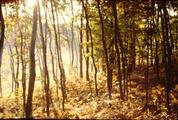Back
Feedback from readers
Updated Nov. 2012
Since I originally wrote the web page describing my technique for copying old slides,
the price of real slide scanners has dropped a lot. I've seen them for as cheap as
$49. So how do these scanners stack up against just using your digital camera?
Several people have been kind enough to write and tell me of their experiences.
Click on any picture below to see a larger version.
This first email is from someone who converts slides as a business, and seems to have
done a lot them:
On Tue, Jun 17, 2008, Shelton Robinson wrote:
I have a one man company in Memphis Tennessee that specializes in transferring media from one for
to another. LP's to CD's, cassette tapes to CD, reel to reel tape to CD, 8mm film to DVD, etc.
But the greatest struggle I've had is in finding a way to transfer large quantities of slides to
digital format. I have a Nikon Cool Scan (expensive and good but S-L-O-W.) The best thing I came
up with is a variation on what you've done, using an expensive (at the time) 4M Olympus E-10 and
E-20. After doing several thousand slides, I burned up the shutters in both of them. I can find
no one who will repair for less than the camera is worth. So... long story short... I have been
looking for an inexpensive digital camera that could be used until it gave up the ghost and then
tossed.
With the Olympus cameras I used a close up lens that cropped just inside the mount and with
careful placement, I could copy with a minimum of cropping in the computer. I even dropped the
quality rating to the equivalent of 1MP and got an image that was very suitable to printing and
more than acceptable for transfer to video (DVD). Also, as far as a light source, I started out
using a slide duplicator with an adjustable color head (Illumitrans, maybe) but found that the
camera was more than capable of color correcting and white light balancing on its own. I also
bought one of the Hammecher Schlemmer scanners and it does quite a good job, too good in fact,
because of its love for showing minute particles of dust on the slide. The cameras are much more
forgiving when it comes to dust, while still giving a good image for print or video.
Here are the comparison slides. The image from the Hammacher Schlemmer unit is on the right,
and the one on the left is from the E-10, shot at SHQ quality. Both images are
about the same file size and image size.
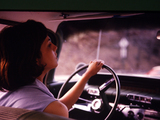
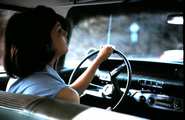 The E-10 is by far the faster of the two methods. The problem is that the shutter can't hold up
to continuous shooting. The issue seems to be the speed at which the shots are done and not the
quantity. If I had let a little more time lapse between shots, I might not have burned up the
shutter. I am now looking for an inexpensive digital camera, plentiful on the used market that I
can buy maybe several at a time so when one gives up the ghost, I can toss it and use another.
The HS unit is OK speedwise, but as you can see, dust is a problem. The E-10 produces almost the
same quality image without the dust.
The E-10 is by far the faster of the two methods. The problem is that the shutter can't hold up
to continuous shooting. The issue seems to be the speed at which the shots are done and not the
quantity. If I had let a little more time lapse between shots, I might not have burned up the
shutter. I am now looking for an inexpensive digital camera, plentiful on the used market that I
can buy maybe several at a time so when one gives up the ghost, I can toss it and use another.
The HS unit is OK speedwise, but as you can see, dust is a problem. The E-10 produces almost the
same quality image without the dust.
Thanks for your article, its good to see the old I-can-make-something-that-will-do-that spirit is
still alive.
The next email is from someone picking through their old slide boxes (like me). She followed
my directions pretty closely:
On Fri, February 19, 2010, Mary LaRue wrote:
The slide viewer (same one in the web article) came in the mail last week. A $31
investment. Roy had to cut off the magnifier per the instruction. I had him
time me as I digitized 31 slides with the camera and it came out to be 30
seconds per slide compared to 5 minutes/slide on the scanner. This was time
total into a file on my PC without any edits. The results were quite good on
the camera, please see enclosed pictures. These were taken in 1980 at Canada
Creek Ranch.
Camera photos on the left, scans on the right:
The camera pictures were cropped and then auto corrected in Microsoft Picture Manager.
The scanned ones were just auto corrected.
I have a kodak Z710 using it in the macro/flower mode. It's doing a good job of it.
I am 63 now and wishing I started this sooner. Truth be told, my slides and
pictures are a complete mess and nothing was marked or even in chronological order.
ONE PICTURE IS WORTH A THOUSAND WORDS.
Mary
Here's a November 2012 email from a man whose company has metalworking skills. He's
taken the original idea and built his own from scratch:
On November 15, 2012 Larry Leino wrote:
Thanks for the excellent idea! My company makes custom industrial machinery, some as far
back as the 1940's. We have literally thousands of slides of shipped machines, most from
the 60r's, 70's and 80's. I work in a customer support role, and occasionally I need to
go back to these archives. Some of those old machines just won't die. We couldn't really
justify buying a commercial digitizer, but this does the job perfectly.
I had a little help from my cohorts in the sheet metal department. As you can see, it's
a 1-piece bent up box. Oh the joys of CAD systems and sheet metal cutting lasers. The
top diffuser plate is Lexan plastic, frosted in the sandblaster. After some experimentation,
I ended up with a pattern of four 2.5V bulbs (couldn't live without Radio Shack) powered
by a 9VDC transformer from my junk box. Total cost, other than what it cost the company
for the sheet metal, is under $10.
Thanks again, and keep up the good work. It.s innovation like this that makes us great.
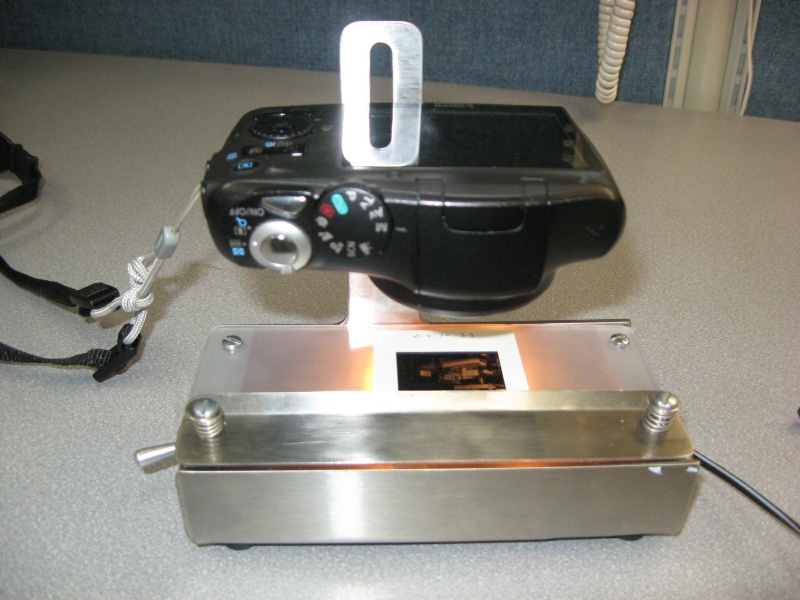
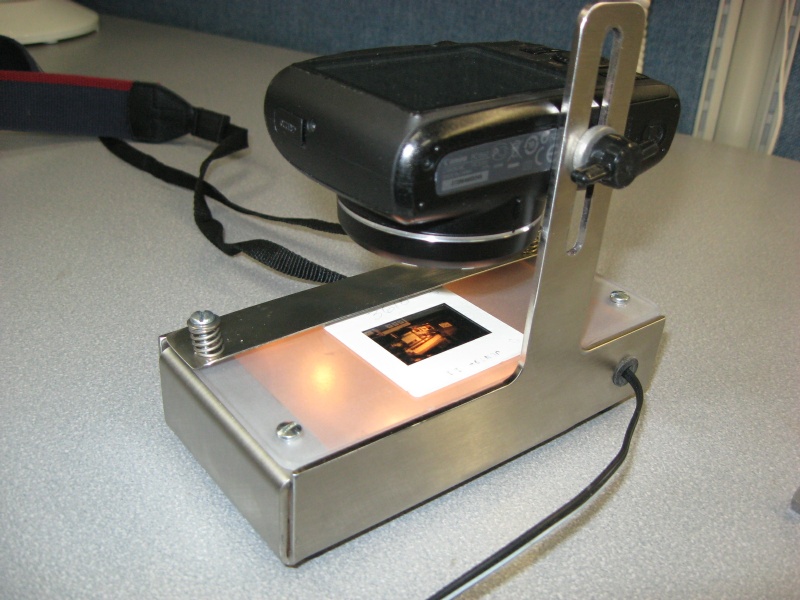
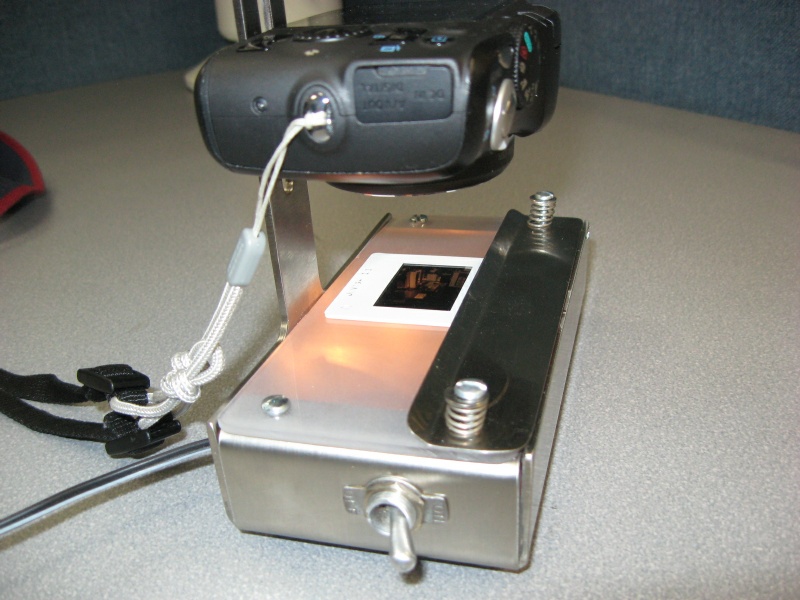

 The E-10 is by far the faster of the two methods. The problem is that the shutter can't hold up
to continuous shooting. The issue seems to be the speed at which the shots are done and not the
quantity. If I had let a little more time lapse between shots, I might not have burned up the
shutter. I am now looking for an inexpensive digital camera, plentiful on the used market that I
can buy maybe several at a time so when one gives up the ghost, I can toss it and use another.
The HS unit is OK speedwise, but as you can see, dust is a problem. The E-10 produces almost the
same quality image without the dust.
The E-10 is by far the faster of the two methods. The problem is that the shutter can't hold up
to continuous shooting. The issue seems to be the speed at which the shots are done and not the
quantity. If I had let a little more time lapse between shots, I might not have burned up the
shutter. I am now looking for an inexpensive digital camera, plentiful on the used market that I
can buy maybe several at a time so when one gives up the ghost, I can toss it and use another.
The HS unit is OK speedwise, but as you can see, dust is a problem. The E-10 produces almost the
same quality image without the dust.



